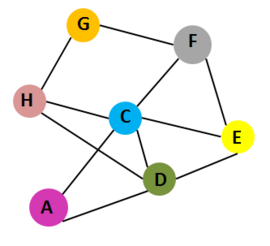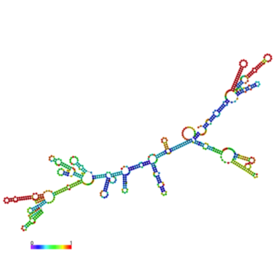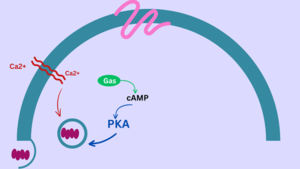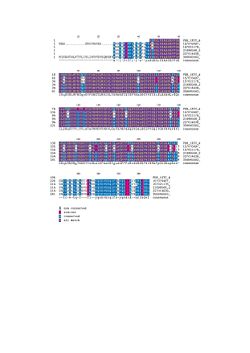Cholera toxin
From Proteopedia
(Difference between revisions)
| Line 1: | Line 1: | ||
| - | + | <StructureSection load='xtc' size='350' side='right' scene='Cholera_toxin/Cv/1' caption='Cholera toxin composed of A1 (grey), A2 (pink) subunit and a pentamer of B subunits (rust, cyan, gold, yellow, purple). [[1xtc]]'> | |
| - | + | ||
[[Cholera toxin]] (CTX), secreted by bacterium [http://en.wikipedia.org/wiki/Vibrio_cholerae Vibrio Cholerae],is an oligomeric complex of enzymatic A and pentameric B subunits, which bind to the cell surface. CTX is the main cause of the diarrhea symptoms of cholera infection. | [[Cholera toxin]] (CTX), secreted by bacterium [http://en.wikipedia.org/wiki/Vibrio_cholerae Vibrio Cholerae],is an oligomeric complex of enzymatic A and pentameric B subunits, which bind to the cell surface. CTX is the main cause of the diarrhea symptoms of cholera infection. | ||
| Line 29: | Line 28: | ||
== Application == | == Application == | ||
Subunit B of cholera toxin is designed to be applied as a neuronal tracer due to its non-toxic characteristic. It also used to identify lipid rafts as florescent tag on the cell surface since lipid rafts contains GM1 gangliosides, which will interact with subunit B during mechanism <ref>Luppi P.H.. "The Discovery of Cholera-Toxin as a Powerful Neuroanatomical Tool". Retrieved 2011-03-23.</ref>. It is demonstrated that cholera toxin subunit B is a sensitive retrograde tracer for the central nervous system <ref>Luppi P.H., Fort P., Jouvet M. Iontophoretic application of unconjugated cholera toxin B subunit (CTb) combined with immunohistochemistry of neurochemical substances: a method for transmitter identification of retrogradely labeled neurons. Brain Res. 534 (1-2) pages : 209-224 (1990)</ref>. | Subunit B of cholera toxin is designed to be applied as a neuronal tracer due to its non-toxic characteristic. It also used to identify lipid rafts as florescent tag on the cell surface since lipid rafts contains GM1 gangliosides, which will interact with subunit B during mechanism <ref>Luppi P.H.. "The Discovery of Cholera-Toxin as a Powerful Neuroanatomical Tool". Retrieved 2011-03-23.</ref>. It is demonstrated that cholera toxin subunit B is a sensitive retrograde tracer for the central nervous system <ref>Luppi P.H., Fort P., Jouvet M. Iontophoretic application of unconjugated cholera toxin B subunit (CTb) combined with immunohistochemistry of neurochemical substances: a method for transmitter identification of retrogradely labeled neurons. Brain Res. 534 (1-2) pages : 209-224 (1990)</ref>. | ||
| - | + | </StructureSection> | |
== 3D Structures of Cholera toxin == | == 3D Structures of Cholera toxin == | ||
Revision as of 12:52, 18 January 2016
| |||||||||||
Contents |
3D Structures of Cholera toxin
Updated on 18-January-2016
Multiple Sequence Alignment
Selected Sequences:
1. Cholera toxin Subunit A
2. Escherichia coli E24377A plasmid pETEC_80, complete sequence
3. Escherichia coli strain 214-III elt operon, complete sequence
4. Vibrio cholerae strain JS9803 prophage Vibrio phage CTX Zot (zot)
5. Vibrio cholera O395 chromosome II, complete sequence
6. Vibrio cholera O1 str. 2010EL-1786 chromosome 1, complete
Reference
- ↑ Ryan KJ; Ray CG (editors) (2004). Sherris Medical Microbiology (4th ed.). McGraw Hill. p. 375. ISBN 0838585299.
- ↑ Faruque SM; Nair GB (editors). (2008). Vibrio cholerae: Genomics and Molecular Biology. Caister Academic Press. ISBN 978-1-904455-33-2.
- ↑ Jennifer McDowall, Cholera Toxin, EMBL-EMI, Interpro
- ↑ Jennifer McDowall, Cholera Toxin, EMBL-EMI, Interpro
- ↑ Davis B, Waldor M (2003). "Filamentous phages linked to virulence of Vibrio cholerae". Curr Opin Microbiol 6 (1): 35–42. doi:10.1016/S1369-5274(02)00005-X. PMID 12615217.
- ↑ Luppi P.H.. "The Discovery of Cholera-Toxin as a Powerful Neuroanatomical Tool". Retrieved 2011-03-23.
- ↑ Luppi P.H., Fort P., Jouvet M. Iontophoretic application of unconjugated cholera toxin B subunit (CTb) combined with immunohistochemistry of neurochemical substances: a method for transmitter identification of retrogradely labeled neurons. Brain Res. 534 (1-2) pages : 209-224 (1990)
External Links
PDB ID: 1XTC [1]
MMDB ID: 52036 [2]
PubMed[3]





